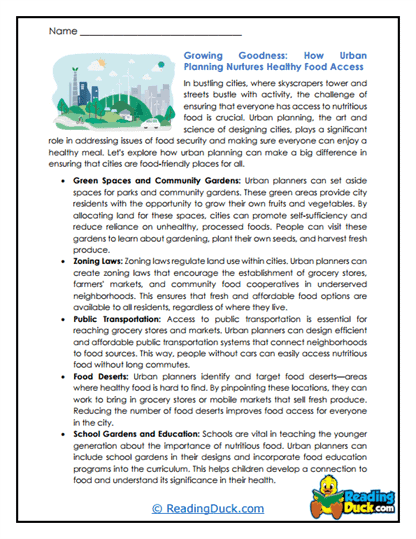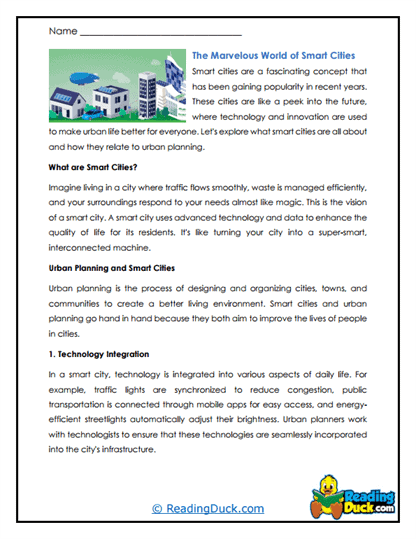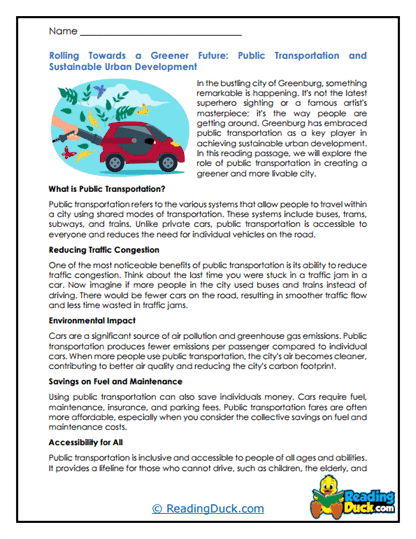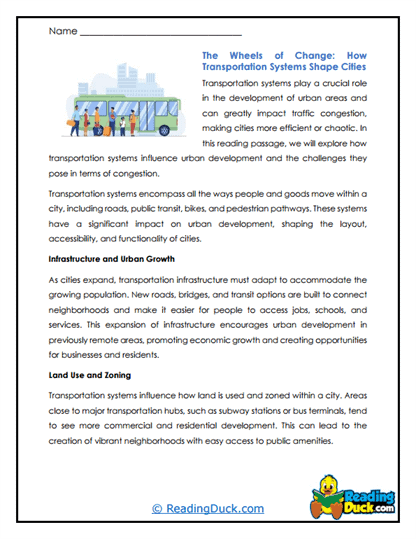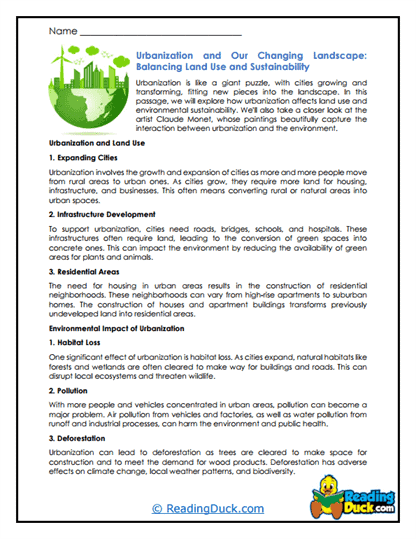Urbanization Worksheets
About Our Urbanization Worksheets
Our Urbanization worksheets are designed to offer students a comprehensive understanding of how cities evolve, the factors that drive urban growth, and the challenges and opportunities presented by urbanization. This collection delves into the historical, social, economic, and environmental aspects of urbanization, providing students with a well-rounded perspective on this critical topic.
Each topic in this collection includes several worksheet sets to engage students actively:
- Multiple Choice Questions: These questions test students' understanding of the reading passages, reinforcing key concepts and details about urbanization.
- Short Answer Questions: These prompts encourage students to articulate their understanding in their own words, promoting critical thinking and deeper engagement with the material.
- Open-Ended Questions: These questions invite students to reflect on the broader implications of urbanization, sharing their opinions, preferences, and personal insights on the topic.
An answer key is provided for every question sheet, and all worksheets are available as PDF files, which can be easily viewed, downloaded, and printed for both classroom and home use.
Understanding Urbanization: Past, Present, and Future
Urbanization is the process through which cities grow, and populations increasingly shift from rural to urban areas. This phenomenon has been a significant force in shaping human history and continues to influence the way we live today. Understanding urbanization involves exploring its historical roots, the factors that drive it, and the challenges and opportunities it presents in the modern world.
Key Aspects of Urbanization:
- Urbanization Through the Ages: Urbanization is not a new phenomenon; it has been occurring for thousands of years. Students will explore the historical development of cities, from ancient civilizations to the modern era, and how urbanization has shaped human societies.
- Factors Driving Rural-to-Urban Migration: Many factors contribute to the movement of people from rural areas to cities, including economic opportunities, access to education and healthcare, and the promise of a better quality of life. Students will examine these drivers and how they vary across different regions and time periods.
- Green Spaces and Parks: As cities grow, the importance of green spaces and parks becomes increasingly apparent. These areas provide vital environmental, social, and health benefits to urban residents. Students will learn about the role of green spaces in urban planning and how they contribute to sustainable urban development.
- Public Transportation and Sustainable Urban Development: Efficient public transportation systems are crucial for reducing traffic congestion, lowering emissions, and promoting sustainable urban growth. Students will explore the challenges and benefits of developing and maintaining public transportation networks in growing cities.
- How Transportation Systems Shape Cities: The design and implementation of transportation systems have a profound impact on the structure and functionality of cities. Students will examine how transportation networks influence urban sprawl, economic development, and social equity.
- Transformation of Urbanization: Urbanization is a dynamic process that continually evolves in response to technological advancements, economic shifts, and social changes. Students will study the transformation of cities over time and how urbanization continues to shape the world.
- Balancing Land Use and Sustainability: Urbanization often leads to competing demands for land use, including housing, industry, agriculture, and natural habitats. Students will explore the challenges of balancing these demands while promoting sustainability and environmental protection.
- Smart Cities: The concept of "smart cities" involves using technology to improve urban living, enhance efficiency, and promote sustainability. Students will learn about the innovations that define smart cities and how these advancements are being implemented around the world.
- How Urban Planners Tackle Public Health and Sanitation: Public health and sanitation are critical concerns in densely populated urban areas. Students will explore the strategies urban planners use to address these issues and ensure that cities are safe and healthy places to live.
- Challenges of Making Cities Affordable: Housing affordability is a significant challenge in many cities, leading to issues such as homelessness and gentrification. Students will examine the factors contributing to housing affordability and the potential solutions to these challenges.
- How Urban Planning Nurtures Healthy Food Access: Access to healthy, affordable food is essential for the well-being of urban populations. Students will learn about the role of urban planning in promoting food security and the strategies used to ensure that all residents have access to nutritious food.
- The Art of Urban Planning: Urban planning is a complex and multifaceted discipline that involves designing and managing the growth of cities. Students will explore the principles and practices of urban planning, including land use, transportation, housing, and environmental sustainability.
These topics provide students with a comprehensive understanding of urbanization, allowing them to explore the factors that drive city growth, the challenges of managing urban areas, and the opportunities for creating more sustainable and livable cities.
Why Urbanization Education Matters: Building Informed Citizens and Future Planners
Understanding urbanization is essential for students of all ages, as it equips them with the knowledge and skills necessary to navigate and contribute to the urbanized world we live in. As more people around the globe move into cities, it becomes increasingly important for students to comprehend the social, economic, and environmental implications of urbanization. This understanding not only helps students appreciate the complexities of city life but also prepares them to address the challenges and opportunities that come with living in urban areas.
Studying urbanization also fosters critical thinking and problem-solving skills, as students are encouraged to explore solutions to real-world challenges such as housing affordability, transportation, and environmental sustainability. By learning about urbanization, students can become informed citizens who are capable of contributing to discussions about urban policy, planning, and development. This knowledge is particularly valuable for those who may pursue careers in urban planning, architecture, public policy, or environmental science, but it also benefits anyone who will live and work in an increasingly urbanized world.
From Social Studies Classes and Beyond
To effectively incorporate the study of urbanization into the curriculum, educators and parents can use the following strategies. These tips ensure that students not only learn about urbanization in social studies classes but also see its relevance across various subjects:
- Interdisciplinary Projects: Connect urbanization studies with other subjects such as geography, economics, and environmental science. For example, students can explore the economic impact of urbanization, the environmental challenges of city growth, or the geographical factors that influence urban development.
- Debates and Discussions: Engage students in debates and discussions on urbanization-related topics. These activities promote critical thinking, allow students to express their opinions, and encourage them to consider multiple perspectives on urbanization and city planning.
- Field Trips and Virtual Tours: Organize field trips to urban centers, planning offices, or historical sites to give students firsthand experience of urbanization. Alternatively, use virtual tours to explore global cities and their unique urban challenges and solutions.
- Guest Speakers: Invite urban planners, architects, or city officials to speak to students about their work and the challenges of managing urban growth. Hearing from professionals provides students with real-world insights and deepens their understanding of urbanization.
- Case Studies: Use case studies to examine specific cities or urbanization issues. Students can analyze how different cities around the world handle challenges such as housing, transportation, and environmental sustainability, comparing and contrasting their approaches.
- Classroom Simulations: Create simulations where students take on the roles of urban planners, government officials, or community members to address urban challenges. These activities help students understand the complexities of urban decision-making and the trade-offs involved.
- Current Events: Incorporate current events into lessons on urbanization. Encourage students to analyze how urbanization is covered in the media, the impact of new policies on city development, and the role of technology in shaping the future of cities.
- Art and Design Projects: Encourage students to express their understanding of urbanization through creative projects, such as designing a sustainable city model, creating artwork that represents urban life, or writing a story set in a future city.
- Interactive Technology: Utilize online resources, such as city planning simulations or interactive maps, to engage students with the material. Technology can provide dynamic and interactive learning experiences that deepen students' understanding of urbanization.
- Community Involvement: Involve students in local urban planning initiatives or community development projects. Participating in real-world activities helps students apply their knowledge of urbanization to make a positive impact in their communities.
By implementing these strategies, educators and parents can create a rich and engaging learning experience that helps students understand the importance of urbanization. These activities not only enhance students' knowledge but also inspire them to think critically about the future of cities and their role in creating sustainable, livable urban environments. Through the study of urbanization, students will gain valuable insights into the challenges and opportunities of city life, preparing them to become informed and active participants in shaping the urban world of tomorrow.


